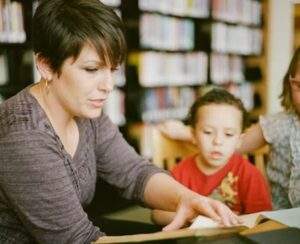Book sharing is an invaluable daily activity in preschool that builds language skills, attention spans, and a lifelong love of reading. Picture books provide engaging educational experiences through enchanting illustrations and storylines appropriate for young listeners. To enrich your storytime rotation, replenish old favorites, and support the curriculum, here are the top picks every preschool teacher’s classroom library needs.
As the foundation for kindergarten readiness, well-selected books should support multiple areas of development. The titles in this piece offer preschool teachers opportunities to introduce new vocabulary, concepts, and themes in developmentally appropriate ways. Replenishing worn favorites and adding fresh selections ensures storytime remains an exciting part of each child’s day.
This blog lists books every preschool should own for her students, categorized by the themes below.

The interaction between early reader and child fosters healthy emotional bonds and learning motivation.
Alphabet Books
Alphabet books help with letter identification in captivating ways. They also introduce letters to young learners in a fun, repetitive ways to help with recognition, phonetics, and pre-reading skills.
- Chicka Chicka Boom Boom by Bill Martin Jr. and John Archambault – This rollicking alphabet rhyme encourages participation.
- The Giving Tree by Shel Silverstein – Beyond ABCs, nature themes promote understanding.
- Seuss’ ABC by Dr. Seuss – This book uses amusing words and pictures to create excitement.
Shapes & Colors
Essential concepts come alive through pictures. Stories about shapes and colors aid visual understanding and vocabulary related to attributes, improving foundations for STEM concepts.
- Brown Bear, Brown Bear, What Do You See? by Bill Martin Jr. – Repeat scenes reinforce properties.
- The Color Monster by Anna Llenas – Diversity education through emotions fosters acceptance.
- A Color of His Own by Leo Lionni – Tolerance messages empower self-expression.
Counting & Math
Interactive stories bring numbers to life. Tales incorporating counting and math spark number sense and one-to-one correspondence through relatable storylines and hands-on elements.
- Ten Little Ladybugs by Melanie Gerth – Manipulating legs strengthens one-to-one skills.
- The Itsy Bitsy Spider by Rosemary Wells – Climbing sequence comprehension inspires.
- Little Blue Truck by Alice Schertle – Community themes nurture cooperation, too.
Science & Nature
Wondrous stories spark scientific wonder. Books exploring science and nature help pique curiosity about real-world phenomena using suitable explanations and illustrations to nurture inquiry.
- The Giving Tree by Shel Silverstein – In this book, nature themes instil environmental care.
- The Tiny Seed by Eric Carle – Plant growth lessons build responsibility.
- Are You My Mother? by P.D. Eastman – Animal babies teach life science gently.
- Where is Your Nose? Robert Schenkel uses engaging but straightforward language and illustrations to help young children recognize and label their body parts. By interacting with the text and following along with the images, kids can improve their understanding of vocabulary and communication abilities. The simple yet engaging presentation supports the development of comprehension and language skills in young readers.
Language Development
Vocabulary expands through classic characters. Classics build oral language through character vocabulary that children love and understand. Repeated reads boost comprehension and conversation.
- Where the Wild Things Are by Maurice Sendak – Imaginations ignite through adventure.
- The Very Hungry Caterpillar by Eric Carle – Metamorphosis teaches cause and effect.
- Goodnight Moon by Margaret Wise Brown – Calming bedtime rituals ease transitions.
Picture books tap into children’s natural curiosity about the world by exposing them to new ideas, people, places, and experiences in an engaging, developmentally appropriate way.

Reading exposes kids to new words and ideas, improving their talk.
Conclusion: Nurturing a Love of Learning
Regular storytimes engage young minds while cultivating kindergarten readiness. Revisiting beloved books develops comprehension and confidence. Most importantly, sharing tales fosters bonding between teachers and students with lifetime impacts. Providing classrooms with these developmental favorites provides enriching early literacy experiences through joy.
Teach Kids with Author Robert Schenkel
As children playfully point to their noses, elbows and eyes in the pages of “Where is Your Nose?”, they learn while they shine under Robert Schenkel’s skilful guidance. His masterful blend of illustrations and text sparks curiosity and boosts comprehension in young readers.

